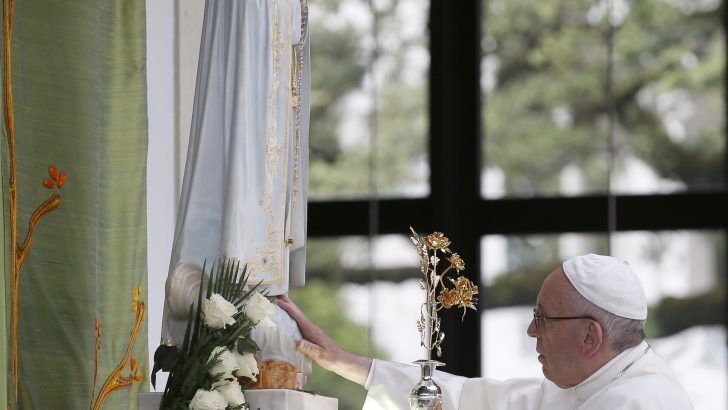Elise Harris
At Sunday’s closing Mass for World Youth Day (WYD) in Panama, it was announced that the next edition of the international festival dubbed the ‘Catholic Woodstock’ will take place in Lisbon, Portugal. While there are undoubtedly multiple reasons, it’s hard not to start with the fact Lisbon is less than an hour’s drive from Fatima – the site of what are, perhaps, the most famous Marian apparitions of all time.
The Lisbon gathering, set for 2022, will mark just the second time the event has focused so pointedly on the Virgin Mary. The previous record-holder for most ‘Marian’ gathering was St John Paul II’s August 10-15, 1991, WYD at the shrine of Jasna Góra in Czestochowa, Poland.
Czestochowa is the site of the widely revered image of Our Lady of Czestochowa, also known as the ‘Black Madonna’ due to years of soot built up from candles left by pilgrims who came to the shrine, lighting the small flame as a sign of their petitions. St John Paul II was hugely devoted to the Madonna of Czestochowa and to Mary generally, so much so that his papal motto, totus tuus, was an expression of his consecration to Mary.
In 2022, just over 20 years after his historic visit to the Polish shrine, Mary will again be the heart of the massive international WYD gathering – in a place with its own painful history of conflict and anti-Catholic sentiment, coupled with deep faith and popular devotion.
War
In 1917, when Mary is believed to have appeared to three shepherd children, Portugal, like most of the world, was embroiled in war.
With World War I raging, Portugal was unable to hold onto its neutrality and eventually partnered with the Allies in a bid to protect their African colonies and maintain trade rights with Britain. Some 220,000 Portuguese civilians died during the war.
Complicating the situation was the fact that the country’s government had been unstable following a revolution and coup d’état, which overthrew the monarchy and led to the formation of the First Portuguese Republic in 1910.
With the advent of a new regime, a fresh constitution was drafted stressing separation of Church and state and sought to banish the faith from public life.
A rise in anti-Catholic sentiment in the post-revolution years led to the government’s seizure of Catholic property, including churches and schools; clergy were forbidden from wearing priestly attire in public; the ringing of church bells was forbidden; and popular cultural festivals and processions were banned. An estimated 2,000 priests and religious were killed between the years 1911-1916.
It was against this backdrop that in 1917, three shepherd children began seeing the Virgin Mary on the 13th of every month from May-October. They were Lucia dos Santos, aged 10 at the time, and her cousins Francisco and Jacinta Marto, 9 and 7.
Revealing herself to the children in a field in Fatima while they were tending sheep, Mary made an appeal for penance and prayer, particularly the recitation of the rosary, and for the children to make sacrifices for the conversion of sinners. She also showed the children a vision of hell, revealing what she said was a “secret” regarding the fate of the world – a secret involving the Second World War, the rise of communism and a request for the Church to consecrate Russia to her Immaculate heart.
It was also in 1917 that Europe was facing some of its most drastic changes, as the Russian revolution was beginning to unfold and the Soviet Union took shape, which would launch its own vicious anti-religious campaign shortly after the USSR was formed in 1922.
In 2022, exactly 100 years later, Fatima will again be the site of a major worldwide event centred around Mary with youth as protagonists. Unless something truly dramatic happens in the meantime, it’ll happen at a time when the global community is again marred by violent conflicts – in this case, what Pope Francis has often referred to as a Third World War being fought “piecemeal.”
Francis has long had a devotion to Mary, and on May 14, 2013, he consecrated his entire papacy to Our Lady of Fatima. In 2017, he visited the Portuguese shrine himself to mark the centenary of the original 1917 apparitions.
While there, he canonised Francisco and Jacinta Marto, marking the first time that children who weren’t martyrs were made saints.
Though as yet no official themes or patrons for the Portugal edition of World Youth Day have been announced, it’s impossible to imagine that the legacy of Fatima won’t be front and centre.
The next version of the largest regular Catholic gathering on the planet, in other words, will be one in which there’s definitely something about Mary.
Elise Harris is Senior Correspondent with Cruxnow.com


 Pope Francis places flowers near a statue of Mary as he prays in the Little Chapel of the Apparitions at the Shrine of Our Lady of Fatima in Portugal in 2017.
Photo: CNS
Pope Francis places flowers near a statue of Mary as he prays in the Little Chapel of the Apparitions at the Shrine of Our Lady of Fatima in Portugal in 2017.
Photo: CNS 